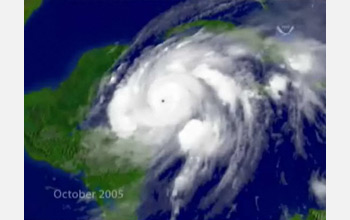News Release 10-127
Birth of a Hurricane
Researchers will fly into tropical weather disturbances and observe their transition into tropical storms
July 27, 2010
View a video of Chris Davis, lead scientist for PREDICT.
This material is available primarily for archival purposes. Telephone numbers or other contact information may be out of date; please see current contact information at media contacts.
Summer storms are a regular feature in the North Atlantic, and while most pose little threat to our shores, a choice few become devastating hurricanes.
To decipher which storms could bring danger, and which will not, atmospheric scientists are heading to the tropics to observe these systems as they form and dissipate--or develop into hurricanes.
By learning to identify which weather systems are the most critical to track, the efforts may ultimately allow for earlier hurricane prediction, and add several days to prepare for a hurricane's arrival.
With primary support from NSF, the Pre-Depression Investigation of Cloud Systems in the Tropics (PREDICT) mission will run from August 15 to September 30, 2010, the height of hurricane season.
Flying aboard the NSF/NCAR Gulfstream V (G-V) research aircraft, formerly known as HIAPER, researchers will make observations from close proximity, and above, storm systems. In addition to deploying dropsondes--parachute-borne instrument packages--the researchers will use remote sensing and cloud physics instruments to gather data on temperature, humidity, wind speed and direction, and characteristics of ice particles and their nuclei, which may include African dust.
"We hope to test recently developed hypotheses about flow features of tropical waves that help distinguish which ones will develop into tropical storms," said Christopher Davis, of the NSF-sponsored National Center for Atmospheric Research (NCAR) and a principal investigator on the project. "These hypotheses require measurements across hundreds of miles, but with details in places down to one mile or so, and even less when we consider the ice particles themselves."
The NSF/NCAR research team will coordinate their observations with two concurrent, but independent, missions in the region: the National Aeronautics and Space Administration (NASA) project known as GRIP (Genesis and Rapid Intensification Processes) and the National Oceanic and Atmospheric Administration (NOAA) IFEX (Intensity Forecasting Experiment).
"The NSF/NCAR G-V offers us unprecedented capability to collect critical atmospheric measurements over regions far larger than has been practical for traditional ‘lower-and-slower' turboprop hurricane-hunter aircraft," added Bradley Smull, NSF program director for Physical and Dynamic Meteorology. "The G-V will allow our investigators to sample the inner workings of a large number of towering tropical cloud systems, and ultimately to better discriminate those that will develop into full-blown hurricanes from those that will not."
In addition to researchers from NCAR, the project will include collaborators from the Naval Postgraduate School, University at Albany-SUNY, University of Illinois at Urbana-Champaign, University of Miami, NorthWest Research Associates of Redmond, Wash., New Mexico Tech, Purdue University, and University of Wisconsin-Madison.
Read more, including specific details about the flight, in the NCAR press release "Hurricane study to tackle long-standing mystery".
-NSF-
Media Contacts
Joshua A. Chamot, NSF, (703) 292-7730, email: jchamot@nsf.gov
David Hosansky, NCAR/UCAR, (303) 497-8611, email: hosansky@ucar.edu
Rachael Drummond, NCAR/UCAR, (303) 497-8604, email: rachaeld@ucar.edu
Program Contacts
Bradley F. Smull, NSF, (703) 292-8524, email: bsmull@nsf.gov
Stephan P. Nelson, NSF, (703) 292-8524, email: snelson@nsf.gov
Principal Investigators
Christopher Davis, NCAR, (303) 497-8990, email: cdavis@ucar.edu
Co-Investigators
Lance Bosart, University of Albany-SUNY, (518) 442-4564, email: bosart@atmos.albany.edu
Michael Montgomery, Naval Postgraduate School Professor, (831) 656-2296, email: mtmontgo@nps.edu
The U.S. National Science Foundation propels the nation forward by advancing fundamental research in all fields of science and engineering. NSF supports research and people by providing facilities, instruments and funding to support their ingenuity and sustain the U.S. as a global leader in research and innovation. With a fiscal year 2023 budget of $9.5 billion, NSF funds reach all 50 states through grants to nearly 2,000 colleges, universities and institutions. Each year, NSF receives more than 40,000 competitive proposals and makes about 11,000 new awards. Those awards include support for cooperative research with industry, Arctic and Antarctic research and operations, and U.S. participation in international scientific efforts.
Connect with us online
NSF website: nsf.gov
NSF News: nsf.gov/news
For News Media: nsf.gov/news/newsroom
Statistics: nsf.gov/statistics/
Awards database: nsf.gov/awardsearch/
Follow us on social
Twitter: twitter.com/NSF
Facebook: facebook.com/US.NSF
Instagram: instagram.com/nsfgov

